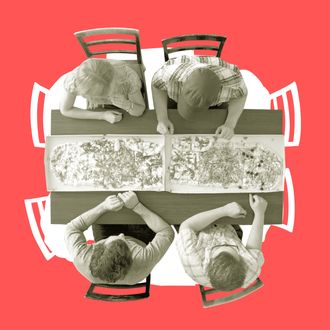
Brian Wansink, the best-selling author and Cornell professor of nutrition science and consumer behavior, has made a career out of studying the ways people accidentally eat more than they intended to. His work examines how environment shapes eating behavior, and how our human predilection toward mindless eating doesn’t have to mean overeating. In an entertaining interview this week with Mother Jones, Wansink takes us through what almost reads like a rundown of his greatest hits — some of the most interesting findings his research has uncovered on the ways we can use mindlessness to improve our eating habits. Here are some of our favorites.
In a restaurant:
Ask to be seated by a window. Wansink’s data show diners who eat next to a window are 80 percent more likely to order salad.
And if you’re trying to avoid sweets, don’t sit at a booth near the bar — according to Wansink’s research, people who sit in that location are 73 percent more likely to order dessert.
Choose a brightly lit restaurant with soft background music and you’ll enjoy your meal more — you’ll also consume fewer calories.
Order whatever it is you actually want. “If you tell people to be mindful of what they order, they don’t like it as much and they make up for it later,” Wansink told Mother Jones. “They tell themselves they deserve ice cream since they virtuously ate a salad for dinner.”
Wansink’s research even shows some very specific rules to remember should you find yourself dining at a Chinese buffet: Eat with chopsticks. Choose a smaller plate. Survey the entire buffet before making your selections. Don’t sit close to the buffet, and make sure you’re facing away from the food.
At home with the kids:
Serve fruit in colorful bowls. Wansink’s research on schoolchildren has found that kids eat double the amount of fruit when it’s served in a colorful dish, as compared to a plainer, metal one.
And cut up their fruit first. Again, in his research in schools, Wansink observed that when schools served sliced apples, 48 percent fewer apples were thrown out without being eaten.
Improve on vegetables’ #branding. Wansink’s data show that kids can be tricked into eating 35 percent more veggies when their veggies are given funny names (X-Ray-Vision Carrots! Silly-Dilly Green Beans!).
At the grocery store:
Spend at least 10 minutes browsing the produce section. Wansink says people who do end up buying more fruits and veggies than shoppers who speed their way through the produce aisles.
Buy the cheaper, bigger box of cereal. Just make sure to divide it up into small containers at home; people tend to eat less when food is served out of a smaller container, according to Wansink’s research.
It’s okay to buy the bagged salad. “Purist cooks say, ‘You’re a lazyhead. You should be doing this yourself.’ That’s what my wife says,” Wansink told Mother Jones. “But when she’s not around, it’s often what I buy. It makes me a whole lot more likely to have a salad, because it takes three steps out of the process.”




